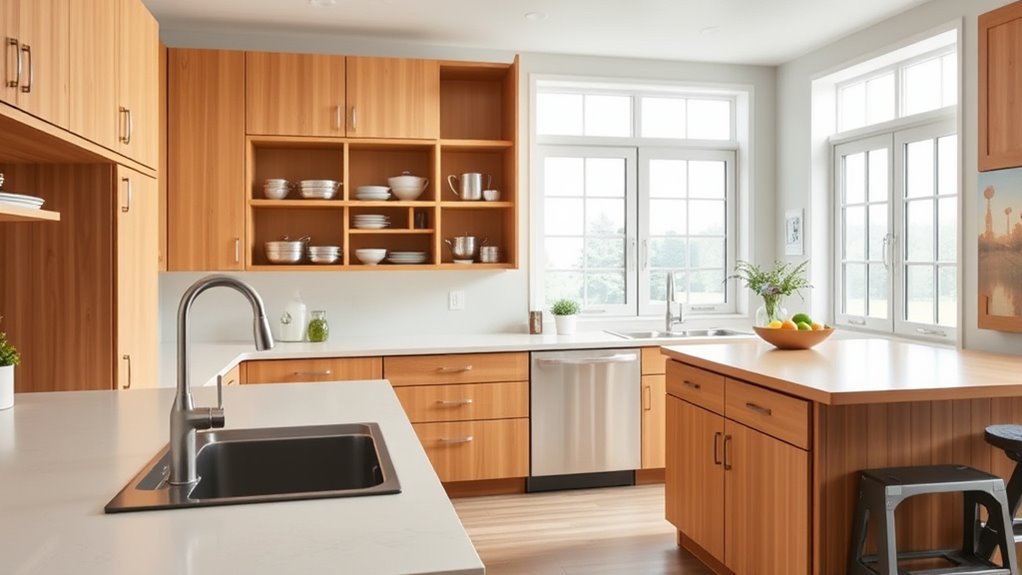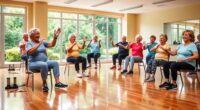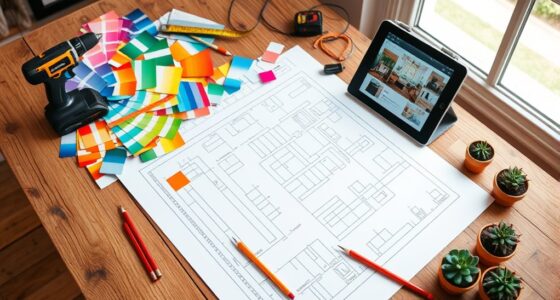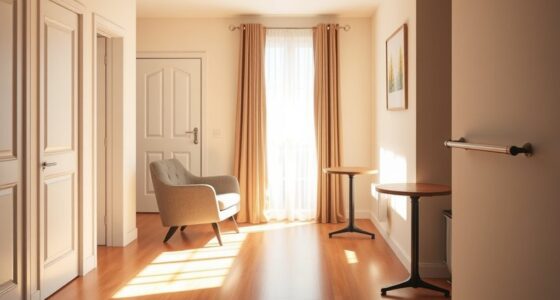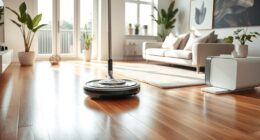To make your kitchen easier to use as you age, focus on accessible storage with pullout shelves, keep key work areas close, and use ergonomic appliances with safety features. Improve lighting with layered, adjustable, and natural options, and add sensors or smart controls for convenience. Confirm flooring is slip-resistant and pathways are wide enough to prevent accidents. For more helpful tips, explore how these modifications can create a safer, more comfortable cooking space tailored to your needs.
Key Takeaways
- Install pullout shelves, soft-close cabinets, and accessible storage to reduce bending and improve item retrieval.
- Keep pathways at least 36 inches wide and position frequently used items within easy reach for safer navigation.
- Use layered lighting, natural daylight, and sensor-activated lights to enhance visibility and safety in all kitchen areas.
- Upgrade to ergonomic appliances, touchless fixtures, and controls within easy reach to minimize strain and hazards.
- Apply non-slip flooring, mats, and safety features to prevent falls and create a secure environment.
Incorporate Pullout Pantry and Accessible Storage Solutions
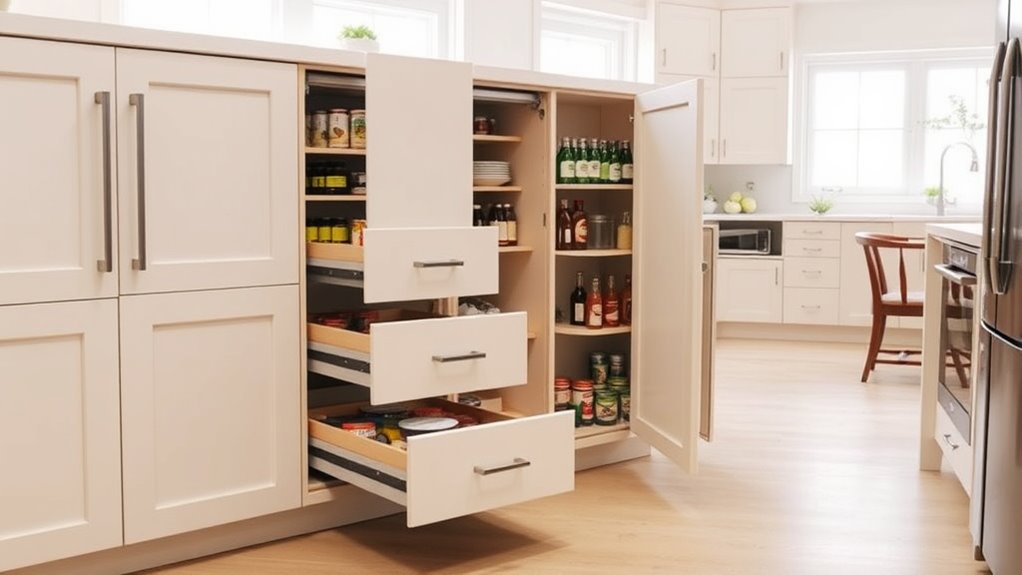
To make your kitchen more accessible as you age, incorporating pullout pantry and storage solutions is essential. A pullout pantry offers full visibility of all stored items at a glance, so you spend less time searching. Affiliate commissions can sometimes be earned from recommended products, providing options tailored to your needs. Accessible storage options like pullout shelves and cabinets make it easier to reach heavy or hard-to-reach items, reducing the need for bending or stretching. Using tiered or sliding shelves maximizes space efficiency, helping you organize your essentials better. In corner cabinets, pullout systems eliminate dead space and provide easier access to items tucked away in deep corners. Choosing adjustable, soft-close pullout storage enhances safety and comfort, especially if you have limited strength or mobility. Incorporating aquatic therapy techniques into your routine can also improve overall mobility and reduce strain when reaching for items. Additionally, implementing organization strategies can help maintain a clutter-free environment and keep frequently used items within easy reach. These features are valuable upgrades during kitchen remodeling, ensuring your space is functional and user-friendly.
Optimize Layout by Keeping Key Areas Close and Clear
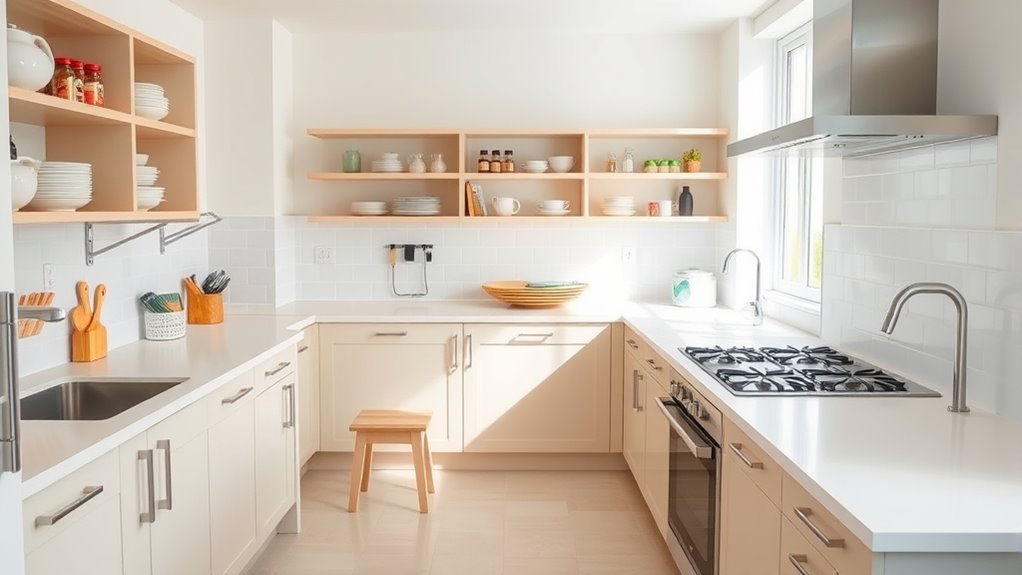
Ensuring your kitchen layout keeps key areas close and clear can considerably enhance safety and ease of use as you age. Prioritize unobstructed pathways by maintaining at least a 36-inch wide clearance in walkways, making movement safer and more comfortable. Incorporate safety features such as non-slip mats and adequate lighting to further reduce hazards. Position frequently used appliances and utensils within easy reach to reduce unnecessary stretching or bending. Keep key work zones—prep, cooking, and cleaning areas—close together to minimize walking distances and streamline your tasks. Design with clear sightlines and open space to improve navigation, especially if you use mobility aids or have visual impairments. Removing clutter and obstructions from pathways not only prevents tripping hazards but also enhances overall accessibility. Incorporating ergonomic tools can help reduce strain and improve comfort during everyday tasks. Understanding angel numbers and how they relate to personal growth can inspire mindful choices in creating a safer, more intuitive kitchen environment. A well-thought-out kitchen layout promotes independence and safety, making your space more functional as you age.
Upgrade to Ergonomic and Safer Appliances and Fixtures

Upgrading to ergonomic appliances and fixtures can make your kitchen safer and easier to use. Choose appliances with front-mounted controls and clear displays to reduce reaching and confusion. Installing touchless faucets and safety-focused cooktops further minimizes hazards and simplifies daily tasks. Regular maintenance and choosing quality appliance upgrades can also help ensure long-term safety and functionality. Additionally, staying informed about digital distractions and their impact on daily routines can help you create a more mindful and efficient kitchen environment. Incorporating proper storage practices can further reduce clutter and prevent accidents, making your kitchen a safer space for aging in place. Incorporating Volkswagen Tuning principles, such as customized modifications and safety enhancements, can serve as inspiration for optimizing your kitchen setup for better performance and safety. Properly leveling fixtures ensures stability and reduces the risk of accidents, contributing to a safer kitchen environment.
Ergonomic Appliance Placement
Placing appliances at or below counter height makes cooking and cleaning safer and easier by reducing bending and reaching. This ergonomic placement enhances appliance accessibility, allowing you to operate devices comfortably without strain. Additionally, integrating natural materials can further create a warm and inviting kitchen environment that supports your needs. When you incorporate thoughtful kitchen design, you create a space that supports your needs as you age, minimizing the risk of slips or falls. Positioning controls and handles within easy reach ensures you can use appliances effortlessly, especially if your dexterity declines. Upgrading to appliances with intuitive interfaces and large displays further improves accessibility. Research indicates that ergonomic design significantly reduces the risk of injuries and enhances overall safety in the kitchen. Incorporating cybersecurity measures into your smart appliances can protect your devices from potential cyber threats, ensuring your connected kitchen remains secure. By focusing on ergonomic appliance placement, you make your kitchen safer, more functional, and better suited to your changing needs, helping you maintain independence and enjoy your space longer.
Safer Fixture Options
Choosing ergonomic and safer fixtures can considerably improve your kitchen’s safety and ease of use. Upgrading to fixtures with safety features reduces the risk of accidents and makes daily tasks easier.
For example, installing lever-handled faucets requires less force, which is ideal if you have limited grip strength or arthritis. Consider switching to induction cooktops with front-mounted controls—these minimize reaching over hot surfaces and lower burn risks.
Replacing standard appliances with built-in, counter-depth models eliminates protrusions, preventing bumps and falls.
Additionally, incorporating pull-under or roll-under sinks with adjustable heights allows wheelchair users to access water fixtures comfortably and independently. Incorporating specialized vacuum cleaners designed for easy handling can help maintain a cleaner and safer kitchen environment, especially for those with mobility challenges.
These safer fixtures are essential for thoughtful kitchen remodeling, ensuring a safer, more accessible space for everyone.
Enhance Lighting for Better Visibility and Safety
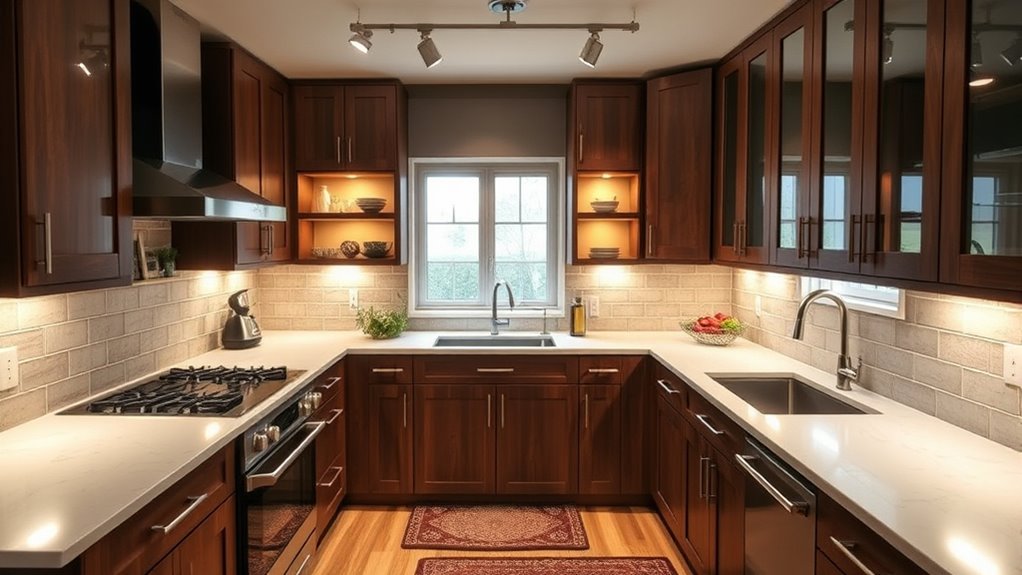
Improving your kitchen lighting makes tasks safer and easier as you age. Using layered lighting, natural light, and safety fixtures helps eliminate shadows and dark spots. Incorporating proper light placement ensures all areas are well-lit, reducing the risk of accidents. These strategies create a bright, flexible environment that enhances visibility and reduces fall risks. Additionally, leveraging AI safety measures in smart lighting systems can optimize illumination based on activity and time of day, further enhancing safety. Understanding developmental milestones related to mobility and vision can help tailor lighting solutions to your specific needs.
Use Layered Lighting Strategies
Layered lighting creates a well-balanced kitchen environment by combining ambient, task, and accent lights to suit different activities and times of day. This strategy guarantees you have easy access to the right light levels, improving safety and visibility.
Incorporate dimmable LED fixtures to adjust brightness as needed, making tasks safer and more comfortable. Under-cabinet lighting provides focused illumination on work surfaces, reducing shadows during food prep. Smart lighting systems can also be integrated to customize lighting settings automatically based on time or activity, enhancing convenience. Additionally, lighting control systems enable seamless adjustment and scheduling, further improving functionality. Using dimming controls allows for precise light level adjustments, further enhancing safety and comfort.
You can also enhance layered lighting with natural light sources like skylights or sun tubes, which boost overall brightness and support circadian rhythms. Proper lighting can also help prevent accidents by ensuring every area is well-lit and visible.
To maximize safety and convenience, consider sensor-activated lights that turn on automatically in low-light conditions, helping you navigate confidently. This layered approach adapts your kitchen to your changing needs, promoting ease and safety.
Maximize Natural Illumination
Maximizing natural illumination in your kitchen involves strategic design choices that bring in more daylight and make the space brighter and safer. Proper window placement, skylights, or sun tubes can flood your kitchen with natural light, reducing the need for artificial lighting and improving visibility. Position work areas near windows to maximize daylight exposure, helping you see clearly and reducing eye strain. Using light-colored or reflective surfaces amplifies natural light, making your kitchen feel more welcoming and easier to navigate. Ensuring unobstructed views and well-placed openings allows consistent daylight flow throughout the day. Incorporating color accuracy considerations into your design can further enhance the overall brightness and visual clarity of your space. Here’s a quick guide:
| Feature | Benefit |
|---|---|
| Large windows | Increase natural light, improve visibility |
| Skylights or sun tubes | Brighten dark corners |
| Window placement | Maximize sunlight during key tasks |
| Reflective surfaces | Amplify natural illumination |
| Unobstructed views | Guarantee consistent daylight flow |
Incorporate Safety-Enhancing Fixtures
To guarantee your kitchen is safe and easy to navigate as you age, incorporating lighting fixtures that enhance visibility is essential. Proper lighting reduces shadows and highlights potential hazards, improving safety.
Use layered lighting options like recessed, task, and ambient lights to create a well-lit space. LED fixtures are ideal for their brightness, energy efficiency, and ability to produce high-contrast illumination, aiding those with poor eyesight.
Motion-activated and sensor lights automatically turn on when you move, ensuring safe navigation in dark areas without manual switches.
Under-cabinet lighting provides targeted task illumination on counters, reducing eye strain and preventing accidents.
Incorporating these safety-focused lighting fixtures creates a safer, more functional kitchen for aging in place.
Implement Smart Technology and Automated Features
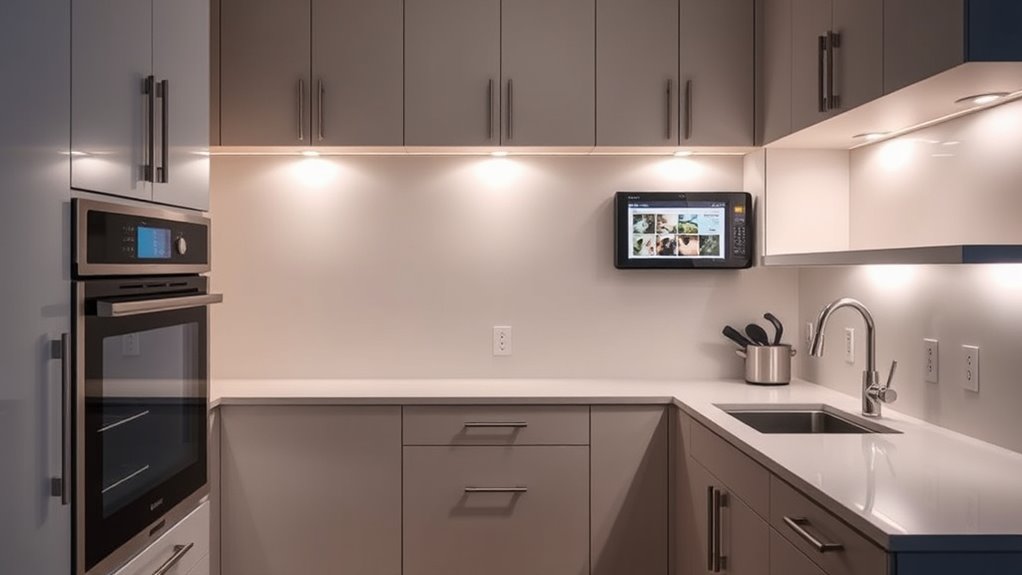
Incorporating smart technology and automated features into your kitchen can considerably improve safety, convenience, and accessibility as you age. With smart technology, you can control appliances remotely via your smartphone or voice commands, making cooking easier and reducing the need for physical effort.
Automated features like touchless faucets activated by hand wave or voice help minimize contact, lowering the risk of cross-contamination and enhancing kitchen safety. Sensor-activated lighting, such as motion sensors and night lights, improve visibility in dark areas or during nighttime use.
Layered lighting options, including dimmable LEDs and natural light, allow you to adjust ambiance and task lighting to suit your needs. These innovations make your kitchen safer, more efficient, and easier to navigate as you age.
Improve Water Management and Waste Disposal Systems
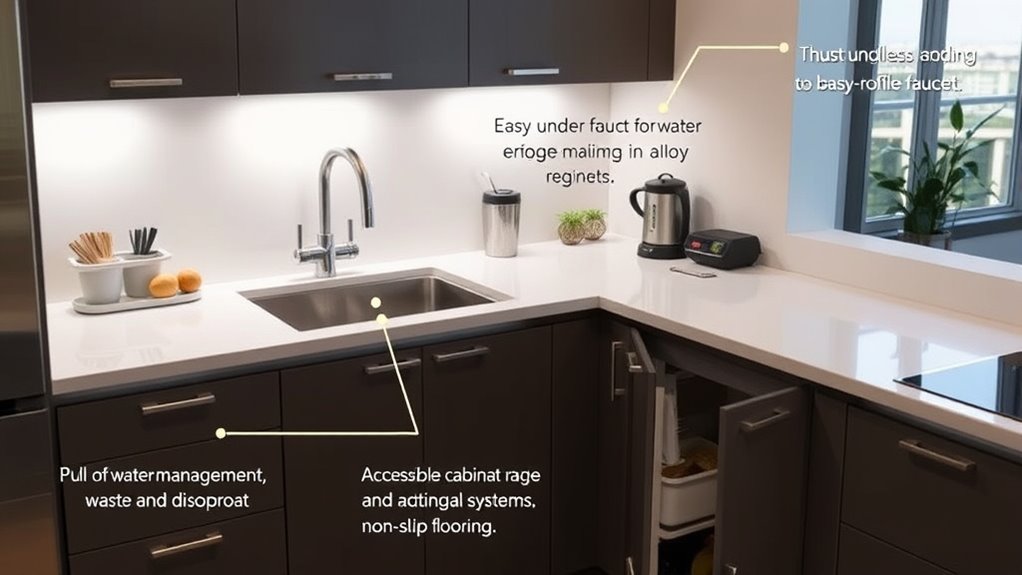
Enhancing water management and waste disposal systems in your kitchen can make daily routines safer and more convenient as you age. Installing hydration stations with filtered, sparkling, or boiling water encourages better hydration and promotes sustainability.
High-end water dispensers, though costly, provide easy access to various water options without lifting heavy bottles.
Motion sensor trash cans open automatically, reducing contact and improving hygiene—some even include odor control and voice command features for added ease.
Dedicated waste disposal solutions help minimize clutter and streamline your waste management process.
- Install hydration stations for easy, accessible water options
- Use motion sensor trash cans to improve hygiene and convenience
- Incorporate dedicated waste disposal systems to reduce clutter and enhance efficiency
Design for Mobility With Wider Clearances and Adjustable Surfaces
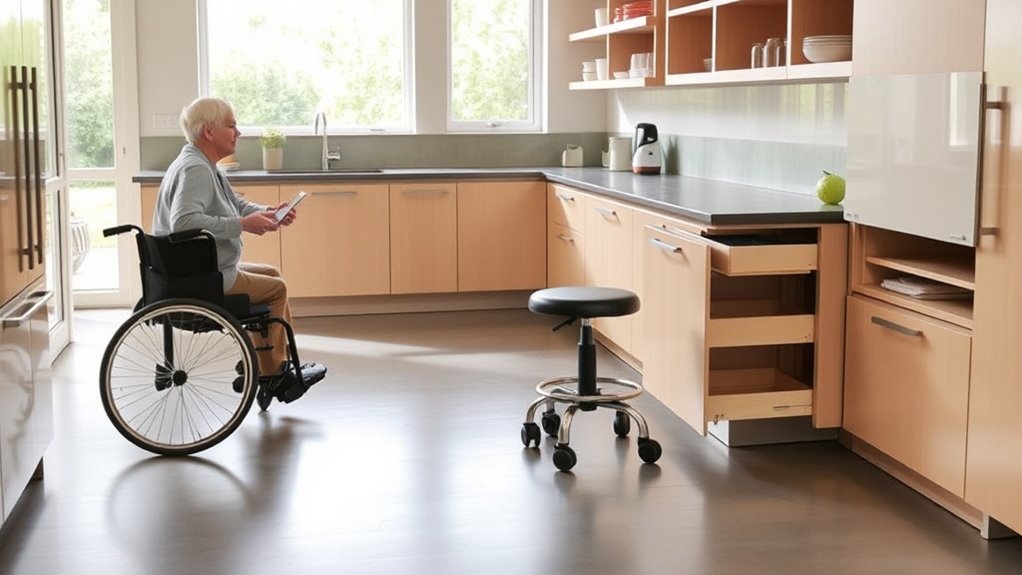
Designing your kitchen for mobility means creating wider clearances and flexible surfaces that accommodate various needs. Aim for at least 36 inches of clearance between countertops and obstacles. Ensure doorways are at least 36 inches wide with pathways of 42 inches in galley kitchens. This allows wheelchairs and walkers to move comfortably.
Incorporate adjustable-height surfaces and motorized counters so you can customize workspace height as needed. All essential controls and appliances should be within reach from both seated and standing positions, reducing strain and improving usability.
Use open floor plans and eliminate barriers like breakfast bars or step-ups to create a truly accessible kitchen. These adjustments make your space more functional, safe, and adaptable as your mobility needs evolve.
Focus on Safety Features and Non-Slip Flooring
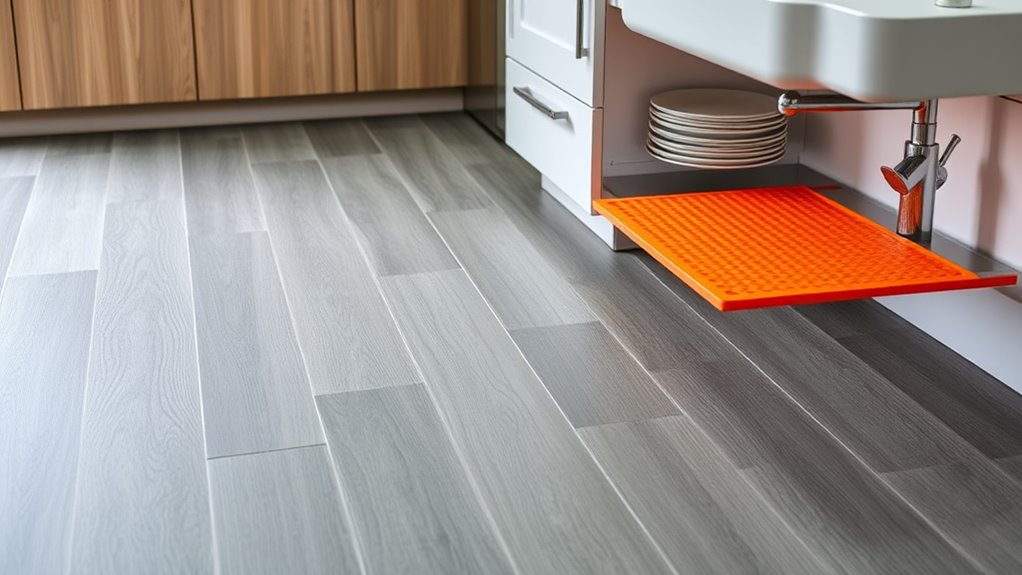
To keep your kitchen safe as you age, focusing on safety features and non-slip flooring can make a big difference. Installing textured grout on tiles or choosing vinyl flooring reduces slip hazards and enhances fall prevention. Porcelain tiles absorb less moisture, further decreasing the risk of slips on wet surfaces.
Adding non-slip mats or rugs with rubber backing provides extra traction in high-traffic or wet areas, reducing the chance of falls. Maintaining clean, dry floors by promptly wiping spills is essential for safety.
Adding non-slip rugs and promptly cleaning spills helps prevent falls and keeps your kitchen safe.
Soft, cushioned flooring materials can also absorb impact, lessening injury severity if a fall occurs. Incorporating these safety features creates a safer environment and promotes confidence while cooking and moving around your kitchen.
- Use textured grout or slip-resistant flooring options
- Add non-slip mats or rugs with rubber backing
- Keep floors clean and dry to prevent slips
Frequently Asked Questions
What Do Old People Struggle With in the Kitchen?
You might find it hard to open heavy cabinets or reach high shelves, especially if your strength or flexibility has decreased.
Bending or kneeling can be painful or difficult, making it tough to access lower cabinets.
Vision issues may make reading labels or seeing small appliances tricky.
Arthritis can limit your grip, and balance challenges increase the risk of falls, especially on slippery or cluttered surfaces.
How to Design a Kitchen for Seniors?
To design a kitchen for seniors, you should prioritize accessibility and safety. Widen doorways to at least 36 inches and ensure clear pathways.
Install lower, pull-out cabinets and use lever handles or touchless faucets for easier use.
Choose appliances with front controls and clear displays.
Improve lighting with layered, natural, and motion-activated fixtures.
Add high-contrast elements to enhance visibility, reducing hazards and making cooking safer and more comfortable.
Can I Redo My Kitchen for $10,000?
Thinking of redoing your kitchen on a $10,000 budget is like trying to squeeze a watermelon into a fruit bowl—challenging but possible.
You can make meaningful upgrades by installing pull-out shelves, lever handles, and better lighting.
Swapping out appliances for smaller models and tackling DIY projects like non-slip flooring also help.
Consulting a CAPS-certified specialist guarantees you get the most bang for your buck, making your kitchen safer and more functional.
What Kitchen Style Never Goes Out of Style?
You ask about a kitchen style that never goes out of style. Classic farmhouse and Shaker designs stand the test of time because of their simple, clean lines and versatile details.
You’ll love the timeless appeal of neutral cabinets paired with natural wood accents, open shelving, and minimalist hardware. These styles combine durability with elegance, offering a warm, inviting space that adapts effortlessly to changing trends and stays beautiful for years.
Conclusion
By making these thoughtful changes, you’ll transform your kitchen into a safe, functional haven that adapts with you. Think of it as planting a sturdy tree—your space will grow more comfortable and accessible over time. Embrace these updates now, and you’ll enjoy cooking and gathering with confidence for years to come. After all, a well-designed kitchen isn’t just a room—it’s the heart of your home, nurturing independence and peace of mind.
